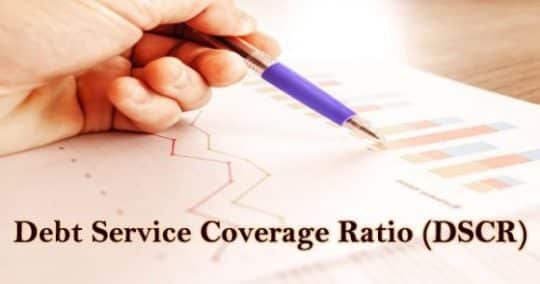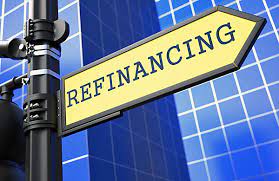The Debt Service Coverage Ratio, abbreviated as DSCR or simply DCR, is a key term in commercial lending and real estate finance. It is essential when underwriting commercial real estate and business loans, as well as tenant financials, and is a significant component in calculating the maximum loan amount. In this article, we’ll go over the debt service coverage ratio in detail and walk through some examples along the way. We’ll also see the two debt service coverage ratio formula and see how to calculate them.
What is Debt Service Coverage Ratio?
The Debt Service Coverage Ratio (DSCR) assesses a company’s capacity to use its operating income to fulfill all of its debt commitments, including principal and interest payments on both short-term and long-term debt. When a corporation has any borrowings on its balance sheet, such as bonds, loans, or lines of credit, this ratio is frequently utilized. It is also a regularly utilized ratio in a leveraged buyout deal, along with other credit indicators such as total debt/EBITDA multiple, net debt/EBITDA multiple, interest coverage ratio, and fixed charge coverage ratio, to analyze the target company’s debt capacity.
Debt Service Coverage Ratio Formula
This debt service coverage ratio formula is in two ways:
Debt Service Coverage Ratio = EBITDA/ (Interest + Principal)
Debt Service Coverage Ratio = (EBITDA – Capex) / (Interest + Principal)
Where:
EBITDA = Earnings Before Interest, Tax, Depreciation, and Amortization.
Principal = The total loan amount of short-term and long-term borrowings.
Interest = The interest payable on any borrowings.
Capex = Capital Expenditure.
Some businesses may prefer to utilize the latter formula because capital expenditure is not expensed on the income statement but is instead regarded as an “investment.” By subtracting CAPEX from EBITDA, the corporation will have the actual amount of operating revenue available for debt service.
How to Calculate Debt Service Coverage Ratio?
This guide will walk you through the process of calculating the Debt Service Coverage Ratio. We’ll go over step-by-step answers to many Debt Service Coverage Ratio Calculations cases.
Example 1 – Income Statement for DSCR
In this example, we will calculate Company A’s Debt Service Coverage Ratio using the following income statement:
| Asset | Million |
| Sales | 1000 |
| Costs of Goods Sold | 200 |
| Gross profit | 800 |
| Operating Expense | 200 |
| Operating Income | 600 |
| Interest Expense | 200 |
| Pre-tax Profit | 400 |
| Tax Expense | 200 |
| Net income | 200 |
Answer
Step 1: Write the debt service coverage ratio formula down.
DSCR = Debt Service / Net Operating Income
Step 2: Calculate the Net Operating Income.
Operating income is calculated by deducting operating expenses from the firm’s gross profit. In this case, it is $600 million.
Step 3: Locate a Debt Service
Because the entity must pay its interest and principal payments before tax, the debt service is often positioned below the operating income. In this example, debt service is simply the interest expense, which is equal to $200M.
Step 4: Perform the calculation to determine the DSCR.
DSCR = Debt Service / Net Operating Income
DSCR = $600M / $200M = 3 (or 3x because it is a ratio)
Example 2 DSCR Simple Income Statement
In this example, we will calculate Company B’s Debt Service Coverage Ratio using the following data and income statement:
Information:
The principal payments total $150 million.
| Asset | Million |
| Sales | 1000 |
| Costs of Goods Sold | 200 |
| Gross profit | 800 |
| SG&A Expense | 300 |
| R&D Expense | 200 |
| Operating Income | 300 |
| Interest Expense | 50 |
| Pre-tax Profit | 250 |
| Tax Expense | 50 |
| Net income | 200 |
Answer
Step 1: Write the debt service coverage ratio formula down.
DSCR = Debt Service / Net Operating Income
Step 2: Calculate the Net Operating Income.
The operating income comes after the operating expenses (SG&A and R&D expenses). In this case, it is $300 million.
Step 3: Locate a Debt Service
In this case, the debt service is higher because the company must repay the principal as well as interest payments.
Debt service equals the sum of interest and lease payments plus principal repayment.
Debt service = $50 million + $150 million = $200 million
Step 4: Perform the calculation to determine the DSCR.
DSCR = Debt Service / Net Operating Income
DSCR = $300 million / $200 million = 1.5 (or 1.5x)
Example 3 – Elements Missing from Income Statement
In this example, we will calculate Company C’s Debt Service Coverage Ratio using the following data and the income statement:
Information:
R&D Expense accounts for 25% of the firm’s SG&A Expense.
Principal payments and interest expenses each account for 10% of the company’s operating income.
The company’s sales are three times the cost of goods sold.
| Asset | Million |
| Sales | ? |
| Costs of Goods Sold | ? |
| Gross profit | 400 |
| SG&A Expense | ? |
| R&D Expense | 200 |
| Operating Income | ? |
| Interest Expense | ? |
| Pre-tax Profit | ? |
| Tax Expense | 50 |
| Net income | ? |
Answer
Step 1: Write the debt service coverage ratio formula down.
DSCR = Debt Service / Net Operating Income
Step 2: Calculate the Net Operating Income.
To determine the firm’s Net Operating Income, we must first compute the Sales and R&D Expenses (since these values are not provided).
Sales = 3 times the cost of goods sold
3 × $400M Equals $1200M in sales
R&D Expense = 25% of SG&A Expense
R&D Expense = 25% of $200M = $50M
Sales – Cost of Goods Sold – SG&A Expense – R&D Expense = Net Operating Income
Net Operating Income = $1200 million – $400 million – $200 million – $50 million = $550 million
Step 3: Locate a Debt Service
Principal payments and interest expenses each account for 10% of the company’s operating income:
10% x Operating Income = Principal Payments
Principal Payments = 10% x $550 million = $55 million
Interest Expense = 10% of Operating Income
Interest Expense = 10% of $550M = $55M
Locate the Debt Service:
Debt service equals the sum of interest and lease payments plus principal repayment.
Debt service = $55 million + $55 million = $110 million
Step 4: Perform the calculation to determine the DSCR.
DSCR = Debt Service / Net Operating Income
DSCR = $550 million / $110 million = 5 (or 5x)
Example 4 – DSCR + Fill out Income Statement
In this example, we will calculate Company D’s Debt Service Coverage Ratio using the following data and a partial income statement:
Information:
The tax rate is set at 50%.
The firm’s R&D Expense is $10M less than half of its SG&A Expense.
The principal payments are equal to twice the pre-tax profit.
The cost of goods sold is 60% of the sales price.
Net Income equals 25% of Lease Payments.
SG&A expenses account for 30% of the company’s sales.
Lease payments are twice as much as interest payments.
Answer
Step 1: Write the debt service coverage ratio formula down.
DSCR = Debt Service / Net Operating Income
Step 2: Complete the income statement.
Because most line items on the income statement are blank, we must first fill out the income statement using the information we have:
Rent Payments
We can figure out the Lease Payments by starting with the Interest Expense of $20M (the only value we have), which is double the Interest Expense.
Lease payments = 2 x $20 million = $40 million
Profitability
We can now calculate the Net Income (because it is 25 percent of the Lease Payments).
Net income = 25% of $40 million = $10 million
Profit Before Tax & Tax Expense
The 50% tax rate suggests that the tax expense is equal to 50% of the Pre-Tax Profit. The company retains half of its Pre-Tax Profit as Net Income. As a result, we can deduce that the Pre-Tax Profit is twice as large as the Net Income.
Profit before taxes = 2 x $10M = $20M
Pre-Tax Profit – Net Income = Tax Expense
Expenses for taxes = $20M – $10M = $10M
Payments of Principal
Principal payments are equal to double the pre-tax profit.
2 x Pre-Tax Profit = Principal Payments
Principal Payments = 2 x $20 million = $40 million
Operating Profit
Although Operating Income is not shown, we can compute it by adding the line items for which we have values above Pre-Tax Profit.
Operating income is calculated as the sum of pre-tax profit and interest expense.
Operating income = $20 million + $20 million = $40 million
Step 3: Locate a Debt Service
Debt service equals the sum of interest and lease payments plus principal repayment.
Debt service = $20 million + $40 million + $40 million = $100 million
Step 4: Perform the calculation to determine the DSCR.
DSCR = Debt Service / Net Operating Income
DSCR = $40 million / $100 million = 0.4 (or 0.4x)
Debt Service Coverage Ratio Interpretation
A debt service coverage ratio of one or greater implies that a company’s operating income is sufficient to cover its annual debt and interest payments. An optimum ratio is 2 or higher as a general rule of thumb. A high ratio indicates that the corporation is capable of incurring further debt.
A ratio less than one is undesirable since it demonstrates the company’s inability to service its present debt commitments solely through operational income. A DSCR of 0.8, for example, shows that there is just enough operational income to repay 80% of the company’s debt payments.
Rather than focusing on a single metric, analyze a company’s debt service coverage ratio concerning the ratios of other companies in the same industry. If a company’s DSCR is much greater than that of the majority of its competitors, it shows stronger debt management. A financial analyst may also wish to examine a company’s ratio over time to see if it is trending upward (improving) or downward (deteriorating) (getting worse).
Common Applications of the Debt Service Coverage Ratio
The debt service coverage ratio is a standard metric used to assess a company’s capacity to pay its outstanding debt, including principal and interest expense.
In a leveraged buyout, an acquiring business uses DSCR to evaluate the target company’s debt structure and capacity to pay loan obligations.
Bank loan officers utilize DSCR to estimate a company’s debt servicing ability.
Summary
The Debt Service Coverage Ratio is a useful indicator for measuring a company’s overall financial health, specifically its ability to service its present debt. The ratio can also help lenders and investors determine if it is safe for the company to take on more debt funding. The DSCR should always be compared to the industry average.
DSCR Frequently Asked Questions
What is a good debt service coverage ratio for real estate?
Most lenders prefer a DSCR in the 1.25x–1.5x range. This means that, at the very least, the asset can generate an additional 25% of additional income after all debt payments have been made.
How do you calculate debt service coverage ratio in real estate?
Simply divide the net operating income (NOI) by the annual debt to determine the debt service coverage ratio.
Why is debt service coverage ratio important?
The DSCR is a useful benchmark for determining an individual’s or a company’s ability to make debt payments in cash. A higher ratio indicates that the firm is more creditworthy since it has enough finances to service its debt commitments – to make the needed payments on time.
- FINANCIAL REPORTING: All you need to know with Examples (+ quick easy tools)
- FINANCIAL STATEMENT OF A COMPANY: Best 2021 Samples & Templates to Learn From
- Commercial General Liability Insurance CGL US: Policy, Coverage, and Costs
- HOUSING RATIO: How to Calculate Housing Ratio with Ease (+ Free Tools)
- Money Management: Top 10+ Easy Tips to Becoming a Pro






